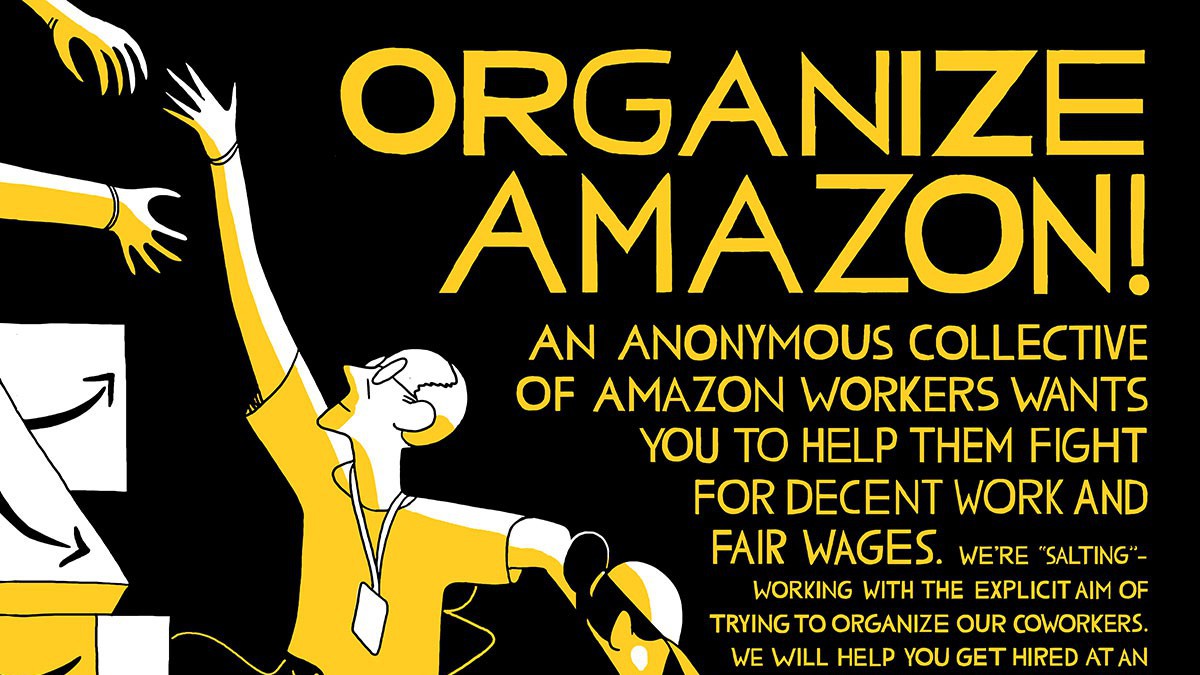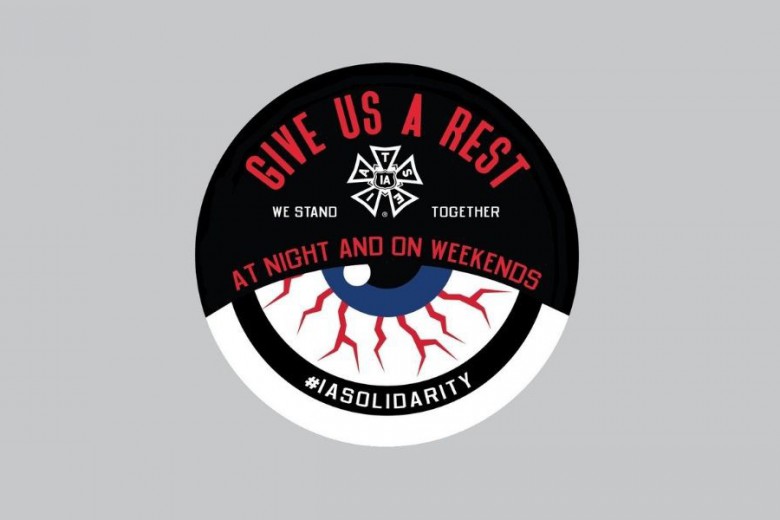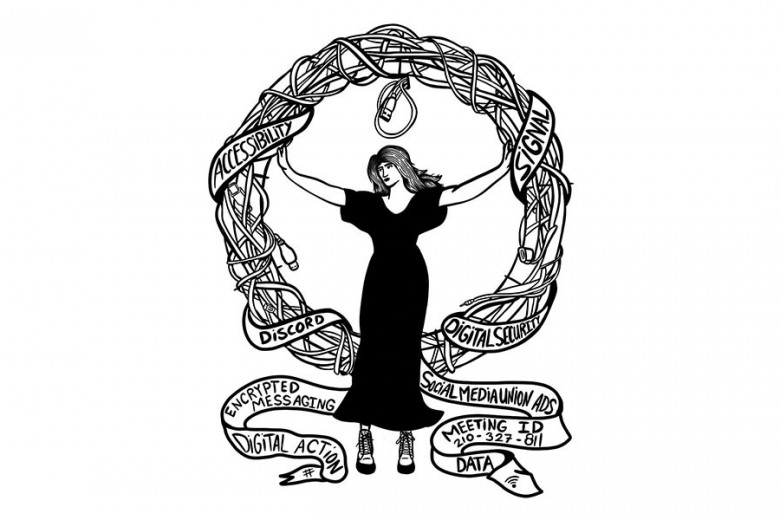Amazon warehouses experience peaks in volume twice every year: during the holiday season and during their summer Prime Day event. To deal with the surge of online orders, Amazon hires extra staff – marking the newbies with white badges and permanent workers with blue ones. White badges come in with the hope that they will survive the peak season to land a permanent position, along with the salary bump and benefits that entails.
The 2019 holiday season was the biggest online shopping event to date. Turning to employment agencies to fill the demand for order pickers and packers, Amazon hired thousands of workers, almost entirely people of colour, swelling the “fulfillment centre” (Amazon-speak for warehouse) in which we work from around 1,800 workers to more than 3,000 in just over a month. The contracts white badges sign make them extremely disposable – workers are paid $15/hour with no paid leave, they must achieve high production rates to maintain employment, and they have a mandatory extra day of work per week remunerated at the regular rate of pay, pushing the work week past 50 hours.
For three months, workers laboured under these gruelling conditions. Then, one day in January after the holiday rush, 1,000 workers were fired at once. They had shown up to work that morning and were simply told their services were no longer needed. We thought this would provoke a riot. But, while angry, workers simply went home.
We are the Amazon Workers Collective. Working inside of Amazon warehouses, we are “salting” – working with the explicit aim of trying to organize our co-workers to form a union. While other unions and non-profit organizations have chosen to use media campaigns to denounce Amazon’s treatment of its workers, hoping to pressure the company to change its practices, we have embedded ourselves inside the company itself, struggling alongside our co-workers in the hopes of creating a culture of solidarity that can one day hold the company accountable. While our progress is slow, we have taken on this project because it has become clear that other methods of organizing at Amazon aren’t working.
Then, one day in January after the holiday rush, 1,000 workers were fired at once. ... We thought this would provoke a riot. But, while angry, workers simply went home.
Since Amazon fired worker and organizing lead Chris Smalls from their JFK8 facility in Staten Island in late March, the company has been targeted by progressive journalists and non-profits. In the U.S., Democratic politicians strut their progressive bona fides with tough rhetoric about taxing billionaires and regulating away Amazon’s power. With the recent groundswell of the Black Lives Matter movement, community groups and civil rights activists have criticized Amazon for providing IT infrastructure for police and the military. Several major unions running ongoing campaigns against Amazon have called for the reform of work-safety legislation and an overhaul of Amazon’s business practices (there are currently three U.S. unions which are publicly courting Amazon workers). The anger is not misplaced, with Amazon worker activists tallying 10 COVID-related deaths and over 1,100 positive cases of the virus at Amazon facilities in the U.S.
But all the negative press hasn’t put a dent in Amazon’s dominance. Not only did the company post record revenues of $75.5 billion for the first quarter of 2020, they managed to hire 175,000 workers in the U.S. and Canada in the space of two months. They set the industry standard with their two-dollar pandemic raise and rejigged their shipment services to keep up with the surging demand brought on by the lockdown. Amazon stock recently surpassed the mythical $3,000-per-share price and CEO Jeff Bezos has added nearly $35 billion to his net worth since the pandemic hit. Chris Smalls has yet to be reinstated, despite calls from New York attorney general Letitia James and New York City mayor Bill de Blasio for a full investigation into his firing. The company withdrew its pandemic raise at the end of May without any major backlash from workers or legislators (a move that was quickly mimicked by other retail and grocery giants) and is going ahead with plans to open several more fulfillment centres in Canada in 2021. This year, while we’re in the throes of a second COVID wave, some 25,000 physical stores in the U.S. are predicted to close, cementing Amazon’s grip over sellers and consumers.
What seems clear from all the previous activism is that workers themselves were hardly part of the equation. Smalls may have become a minor celebrity after his firing, but the number of workers who took part in the walkout, while certainly greater than the 15 that Amazon claims, was only a tiny fraction of the 4,500 employed at the facility. Despite all the hype, the message that workers deserve better safety, pay, and conditions is not inspiring workers to act – either because workers cannot hear it or because they are too scared, tired, and indifferent to rise up.
This year, while we’re in the throes of a second COVID wave, some 25,000 physical stores in the U.S. are predicted to close, cementing Amazon’s grip over sellers and consumers.
In the warehouses, it’s widely understood that conditions are terrible. COVID-19 aside – which has of course made things worse – three workers fainted on the job at one of our facilities last month, mostly due to the bad ventilation and intense pace of work. These incidents went unreported in the media, resulted in no workers’ compensation applications, and did not halt production in any significant way. Walking over 30 kilometres every day and performing the same task tens of thousands of times a week makes repetitive strain injuries common. But it is the pace of the work that leads to more dramatic incidents.
Amazon tracks our rate of work through the scanners that we use to process orders. The rates are an index for the competition that takes place between each warehouse to see which one can process the most orders, constantly driving up the pace of work. This style of management leads both to a gamification of work as well as to tremendous anxiety about being fired. It is when workers feel they are behind and are rushing to achieve their rates that the worst incidents occur. One of us witnessed a collision between two rushed workers picking items in a narrow aisle, causing one to sustain a concussion. The worker who suffered the concussion was sent home and then missed a week of work because they were suffering from migraines. They never filed a workplace injury claim and were not paid for their time off. Using an in-house health-care provider, Amcare, whose staff systematically discourage workers from properly following up on workplace injuries, Amazon manages to dodge many of their workers’ compensation obligations, leaving employees on the hook for their recovery. This exacting environment breeds compliance. The combination of the difficult pace and standard of work, as well as the high injury rate, resulted in a turnover rate of around 100 per cent in the first seven months of the pandemic.
Despite all the hype, the message that workers deserve better safety, pay, and conditions is not inspiring workers to act – either because workers cannot hear it or because they are too scared, tired, and indifferent to rise up.
Over the months – and, for some of us, years – we’ve spent on the inside, we’ve tried to roll the negative energy into productive organizing. But it’s extremely difficult. Amazon specifically recruits from groups of precarious workers who are unable to find better jobs. “I know it’s bad,” they’ll say, “but what am I going to do? I have a family.” For many of these workers, a union is a new concept. Meanwhile, Amazon’s barrier to entry is low: Many workers with only a high school diploma or who were formerly incarcerated say they make better money here than they have anywhere else. For those perseverant (and lucky) enough to get a permanent position, the benefits package is extremely competitive, and with Amazon stock now exceeding $3,000 per share, the employee shares program can represent a significant chunk of money.
We are organizing workers, but the process is slow. Building trust takes time, often more time than it takes for the workforce to turn over. Some of us have made multiple attempts at building workplace committees. After the company sniffed out the initial phase of an organizing drive at one of our facilities last year, they fired key organizers and brought in a $0.95/hour raise, freezing almost all organizing efforts for several months. As a former Amazon executive said, a union “is likely the single biggest threat to their business model.” Amazon knows this, and that is why we need more salts. We need salts to map the workplace and find sympathetic workers, develop strategies to push forward campaigns, and help plan actions to increase power on the work floor. We need more salts because workers need to know that a better workplace is possible and that it’s their co-workers who will stand with them to fight for it.
As a former Amazon executive said, a union “is likely the single biggest threat to their business model.” Amazon knows this, and that is why we need more salts.
For every union, politician, or community group who thinks that a press release denouncing Amazon’s mistreatment of workers is going to bring decisive change, consider that Amazon has gained in public favourability ratings during the pandemic. Amazon has become lodged in our society. The only way to exorcise it is to organize it.
This means doing the hard work of talking to workers about their issues, developing relationships and trust, planning with them to achieve small victories, and building something bigger. This can only be done from the inside. A union at Amazon will force industries across all sectors to follow suit, resulting in higher wages, better job security, and safer work conditions.
So if you’re ready to help, please get in touch by emailing [email protected]. We will help you get hired at an Amazon facility, train you in organizing, and connect you to an existing network of activists. Amazon is a company the likes of which the world has never seen before. This is the fight of our lives, and we’d love to have you on our side.
To help spread the word, print out this poster and stick it up around your neighbourhood!







